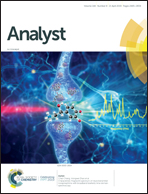Predictive modelling of colossal ATR-FTIR spectral data using PLS-DA: empirical differences between PLS1-DA and PLS2-DA algorithms†
Abstract
In response to our review paper [L. C. Lee et al., Analyst, 2018, 143, 3526–3539], we present a study that compares empirical differences between PLS1-DA and PLS2-DA algorithms in modelling a colossal ATR-FTIR spectral dataset. Over the past two decades, partial least squares-discriminant analysis (PLS-DA) has gained wide acceptance and huge popularity in the field of applied research, partly due to its dimensionality reduction capability and ability to handle multicollinear and correlated variables. To solve a K-class problem (K > 2) using PLS-DA and high-dimensional data like infrared spectra, one can construct either K one-versus-all PLS1-DA models or only one PLS2-DA model. The aim of this work is to explore empirical differences between the two PLS-DA algorithms in modeling a colossal ATR-FTIR spectral dataset. The practical task is to build a prediction model using the imbalanced, high dimensional, colossal and multi-class ATR-FTIR spectra of blue gel pen inks. Four different sub-datasets were prepared from the principal dataset by considering the raw and asymmetric least squares (AsLS) preprocessed forms: (a) Raw-global region; (b) Raw-local region; (c) AsLS-global region; and (d) AsLS-local region. A series of 50 models which includes the first 50 PLS components incrementally was constructed repeatedly using the four sub-datasets. Each model was evaluated using six different variants of v-fold cross validation, autoprediction and external testing methods. As a result, each PLS-DA algorithm was represented by a number of figures of merit. The differences between PLS1-DA and PLS2-DA algorithms were assessed using hypothesis tests with respect to model accuracy, stability and fitting. On the other hand, confusion matrices of the two PLS-DA algorithms were inspected carefully for assessment of model parsimony. Overall, both the algorithms presented satisfactory model accuracy and stability. Nonetheless, PLS1-DA models showed significantly higher accuracy rates than PLS2-DA models, whereas PLS2-DA models seem to be much more stable compared to PLS1-DA models. Eventually, PLS2-DA also proved to be less prone to overfitting and is more parsimonious than PLS1-DA. In conclusion, the relatively high accuracy of the PLS1-DA algorithm is achieved at the cost of rather low parsimony and stability, and with an increased risk of overfitting.



 Please wait while we load your content...
Please wait while we load your content...